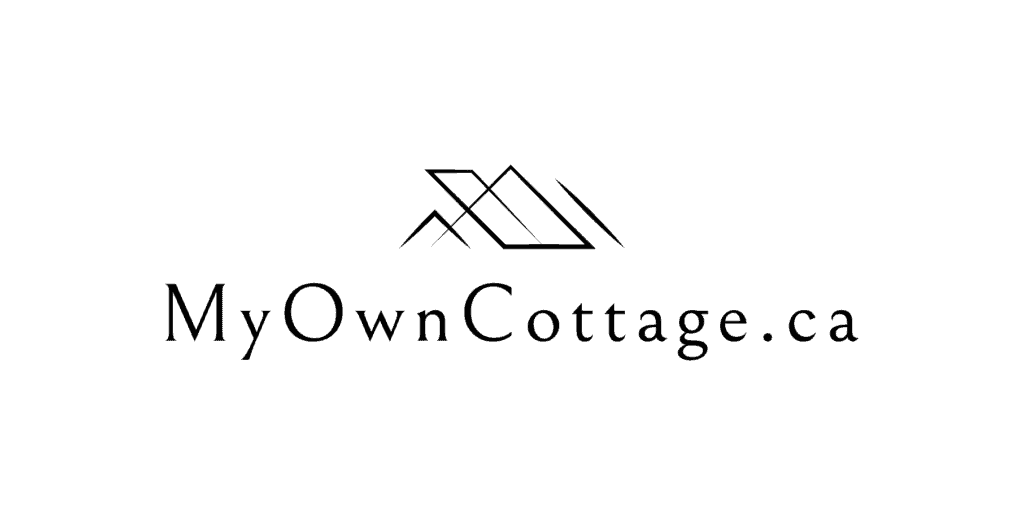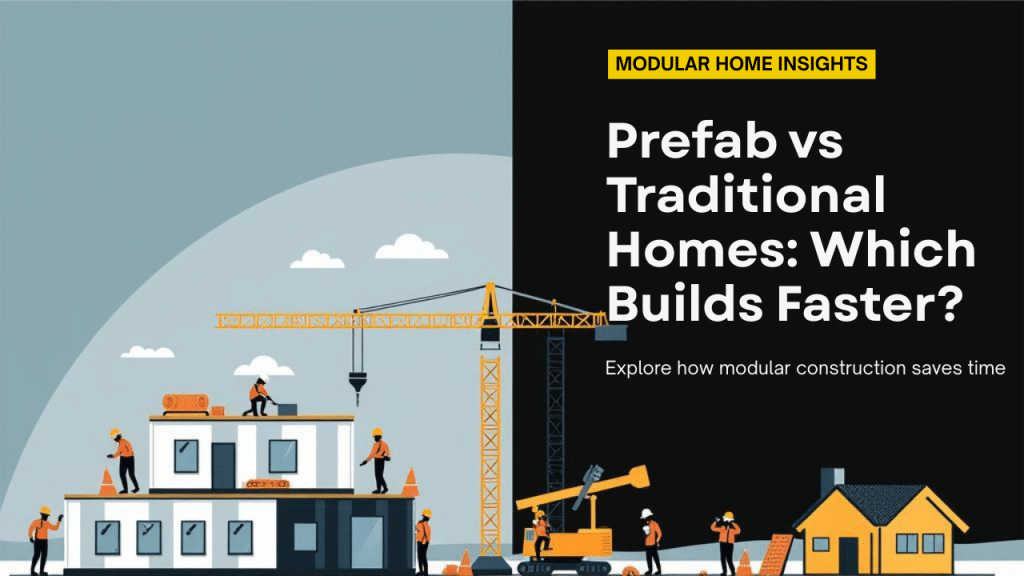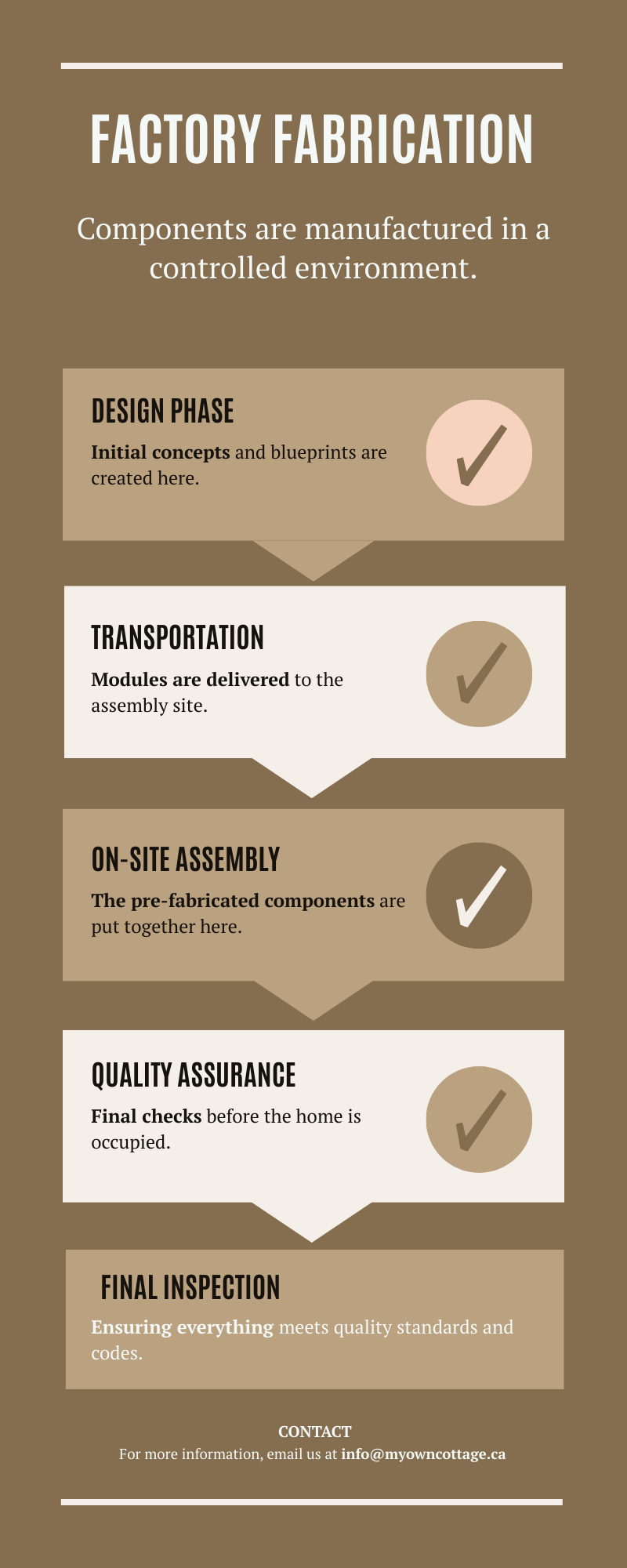Are Prefab Modular Homes Faster to Build Than Traditional Homes?
Last updated: September 4th, 2025
With housing demand at record highs, many families are asking the same question: are prefab modular homes in Ontario faster to build than traditional houses?
In today’s market, where construction delays often push move-in dates back by months—or even years—build speed is a major advantage.
Prefab Modular Homes vs Traditional Construction: Which Is Faster?
Key Takeaway:
Prefab modular homes are usually completed much faster than stick-built houses. Because construction happens in a factory-controlled environment, delays from Ontario’s unpredictable weather are minimized.
At the same time, site preparation can occur in parallel, cutting weeks—or even months—off the total build timeline.
By comparison, traditional on-site construction faces frequent setbacks from weather, trade scheduling conflicts, and material shortages. This makes move-in dates less predictable, especially in high-demand housing markets.
In this guide, we’ll explore the differences in construction speed, efficiency, and common delays so you can decide which method works best for your family.
👉 While this page compares prefab modular homes to traditional construction, you may also want to explore the differences between prefab and modular homes in Ontario to understand how these terms are used in the housing market.
How Prefab Modular Homes Are Built
The Modular Construction Process
Prefab modular homes are built in climate-controlled factories, protected from Ontario’s unpredictable weather. This streamlined approach offers several time-saving advantages:
Simultaneous construction: Multiple sections (or “modules”) are built at the same time.
Parallel site preparation: The building site is prepared while the home is under construction in the factory.
Quick assembly: Once complete, modules are transported to the site and assembled in just a few days.
This efficiency is one of the main reasons prefab modular homes are faster to build than traditional stick-built houses.
Traditional Homebuilding Explained
By contrast, traditional stick-built homes follow a linear construction process: foundation first, then framing, roofing, plumbing, electrical, insulation, and interior finishing—all completed on-site.
This step-by-step approach often results in delays caused by:
Weather interruptions: Snow, rain, or extreme heat can halt progress for days or weeks.
Permit backlogs: Municipal approvals may take longer than expected, slowing down the timeline.
Trade scheduling conflicts: Coordinating multiple subcontractors can create bottlenecks.
As a result, traditional builds in Ontario frequently extend far beyond their original schedules—sometimes by several months or more.
Timeline Comparison – Prefab vs. Traditional Homes
Average Construction Timelines in Ontario
In Ontario, average build times show a clear difference:
Prefab modular homes: 3–6 months on average
Traditional stick-built homes: 9–18 months, depending on design complexity and site conditions
This makes prefab modular homes one of the fastest construction methods in Ontario, offering families a quicker path to move-in compared to traditional builds.
Review the steps involved in buying a prefab modular home in Ontario to see how efficiency impacts each stage.
Why Prefab Modular Homes Are Faster
Prefab construction gains its speed advantage from three key factors:
Controlled environment → No weather delays: Modules are built indoors, unaffected by Ontario’s snow, rain, or heat.
Parallel workflows → Site prep + module building at the same time: While the foundation is poured on-site, the home is already under construction in the factory.
Efficient labor use → Consistent factory shifts: Dedicated crews work on predictable schedules, avoiding the trade conflicts common in stick-built homes.
Together, these efficiencies make prefab modular homes one of the quickest home construction methods compared to traditional houses.
Important to Know: Prefab Isn’t Delay-Proof
While prefab modular homes are faster on average, they don’t guarantee zero delays. Timelines may extend if:
Municipal permits take longer than expected – Local approval backlogs can hold up both prefab and traditional projects.
Extensive customization is requested – Highly personalized layouts or finishes can add time to the factory build.
Transport and delivery face challenges – Road restrictions, weather, or scheduling conflicts may slow module delivery.
By planning ahead and working with an experienced Ontario builder, most of these risks can be minimized.
✅ Note: While prefab modular homes are typically faster to build, extensive customization options for prefab modular homes in Ontario can also sometimes extend timelines.
Real-World Experiences in Ontario
Ontario Homeowners’ Stories: Modular vs. Traditional Timeline
Toronto homeowner Amir S. shared his experience:
“We signed in March and moved in by August—barely five months. Friends building a traditional home at the same time are still waiting.”
This firsthand account highlights the modular home construction time compared to stick-built alternatives.
For many Ontario buyers, stories like Amir’s show how prefab homes can save months on the path to move-in.
Builder Insights: Data on Modular vs. Traditional Timelines
Ontario modular builders often report project completion up to 70% faster than conventional builds.
Industry research supports this claim: according to the Canadian Manufactured Housing Institute (CMHI), modular construction can reduce project schedules by 30–50% on average compared to traditional on-site methods.
These statistics confirm what many homeowners experience first-hand—prefab modular homes consistently reach completion faster than stick-built houses.
Beyond Speed – Other Benefits of Prefab Modular Homes
Cost Efficiency: Are Prefab Homes Cheaper Than Traditional Homes?
Many Ontario buyers ask, “how much do prefab modular homes cost in Ontario compared to traditional homes?”
Reduced labor hours: Factory-built homes use streamlined assembly, lowering on-site labor expenses.
Shorter financing timelines: Faster completion means buyers pay less in construction loan interest and temporary housing costs.
Together, these factors often make prefab modular homes more cost-efficient than traditional houses, though the total savings depend on design complexity and customization choices.
Explore the available financing options for prefab modular homes in Ontario to understand how lenders view shorter timelines.
Sustainability & Energy Efficiency: Prefab vs. Traditional Homes
Prefab modular homes are designed with energy-efficient insulation and precision-sealed construction, often exceeding Ontario’s building code requirements.
For homeowners, this translates into:
Lower utility bills from reduced heating and cooling loss
Consistent indoor comfort due to tighter seals and better insulation
Long-term savings that can add up significantly compared to traditional homes
In many cases, prefab modular homes outperform stick-built houses in energy efficiency, making them both cost-effective and environmentally friendly.
Moreover, many prefab modular homes are built to exceed Ontario building code requirements for modular homes, ensuring long-term durability and efficiency.
Reduced Construction Waste
Prefab modular homes generate significantly less construction waste than conventional builds because materials are pre-measured and cut in factory settings.
Off-site precision means fewer excess materials end up in landfills, and leftover resources can often be recycled for future projects.
This efficiency aligns with Ontario’s green building initiatives, making prefab a sustainable choice for eco-conscious homeowners.
Importantly, even though prefab homes are assembled quickly, many remain adaptable for the future.
Learn whether prefab modular homes can be expanded or upgraded after installation.
Conclusion: Prefab vs. Traditional Home Build Times in Ontario
So, which is quicker—prefab or traditional homes?
In most cases, prefab modular homes in Ontario are faster to build, often saving buyers several months compared to traditional stick-built houses. That said, timelines still depend on factors like municipal permits, customization requests, and builder availability.
If your priority is moving into your dream home sooner—without sacrificing quality—prefab modular construction is often the better choice.
Ready to explore or get started?
Simply book a free consultation, call us directly, or view our design catalogue today.
🧑💼 Request a Free Consultation
📲 Call Us Directly: (705) 345-9337
🏘️ View Our Design Catalogue
✅ Ontario-Built | ⚡ Energy-Efficient | 🏡 Fully Customizable | 🚚 Fast Delivery
Alternatively, for your convenience, you can also simply fill out the contact form below and we’ll get back to you soon! 👇
FAQ: Are Prefab Modular Homes Faster to Build than Traditional Homes?
Are prefab modular homes faster to build than traditional homes?
Yes. Prefab modular homes are built in factory-controlled environments while site prep occurs simultaneously, reducing overall timelines by 20–50%, with many projects completed in 3–9 months, compared to 9–18 months for traditional builds.
How long does it take to build a prefab home in Ontario?
Typically 3–6 months from start to finish—factory build and site assembly happen in parallel—versus 9–18 months for stick-built homes. Actual timelines may vary based on permits, customization, and logistics.
Why are prefab homes faster to build?
Because they use controlled factory construction, allow simultaneous site and module work, benefit from assembly-line efficiency, and avoid weather and labor delays.
What is the modular home construction process?
Modules are built off-site in factories, often using 3D modeling and assembly-line techniques, then transported and assembled on site, streamlining build time and improving quality.
What factors can delay modular home construction?
Delays can arise from slow municipal permits, extensive customization, transportation logistics, and zoning restrictions. Transportation of large modules may incur extra costs.
Are prefab homes cheaper than traditional homes?
Generally, yes—labor savings, reduced build time, and efficient material use typically result in 10–20% lower costs than traditional homes. Savings can be up to 20%, though transportation and foundation costs still apply.
Do prefab homes appreciate in value like traditional homes?
Yes—properly built modular homes meet all codes and house valuation standards, and studies show they appreciate similarly—or occasionally even more—than stick-built homes.
How sustainable and energy-efficient are prefab modular homes?
Very. They reduce construction waste by up to 50–90%, provide superior insulation and precision building, and offer eco-friendly, green-building options.
Can prefab homes be built in winter in Ontario?
Yes. Factory construction shields modules from winter weather, while site preparation and final assembly can proceed under controlled timelines.
How durable are modular homes compared to traditional homes?
Modular homes are built to the same codes (e.g., IRC) and standards as traditional homes, offering equivalent durability and longevity—often with better factory-controlled quality.
What permits are needed for prefab homes in Ontario?
The same municipal building permits, zoning approvals, and foundation inspections required for traditional builds apply. Consult your local jurisdiction for details.
What are the hidden or added costs in prefab modular construction?
Besides the home itself, expect costs for land, foundation, utility hookups, soil testing, and occasionally higher logistics/transportation fees.
Are prefab modular homes worth it in Ontario?
For many, yes—especially when speed, cost-efficiency, sustainability, and value are priorities. Prefab modular homes typically offer faster construction, lower costs, and modern efficiency, making them an attractive alternative to traditional builds.
Who are reputable modular home builders in Ontario?
Ontario is home to several reputable prefab modular home builders. One sterling example is My Own Cottage, a trusted Ontario-based company specializing in affordable, customizable modular homes. They are known for:
Fast build times (often 3–6 months)
Transparent pricing models with clear cost breakdowns
Energy-efficient and eco-friendly designs tailored for Ontario’s climate
Strong customer reviews highlighting reliability and service
Other respected builders in Ontario include Royal Homes, Guildcrest Homes, and Quality Homes, each offering different price points and customization options.
🛡️ Verified Third-Party Resources
For added confidence and transparency, here are trusted external sources that support modular homebuilding in Ontario:
Ontario Building Code (O. Reg. 332/12)
Official provincial regulations that govern modular and factory-built homes.Tarion Warranty Corporation
Provides home warranty coverage and builder licensing in Ontario.Canadian Home Builders’ Association (CHBA)
National organization supporting residential construction, modular certification, and best practices.CMHC – Canada Mortgage and Housing Corporation
Federal housing authority offering insights on modular housing affordability, financing, and energy efficiency.Statistics Canada: Housing Data
Data-driven research on Canadian housing trends, ownership, affordability, and construction.



